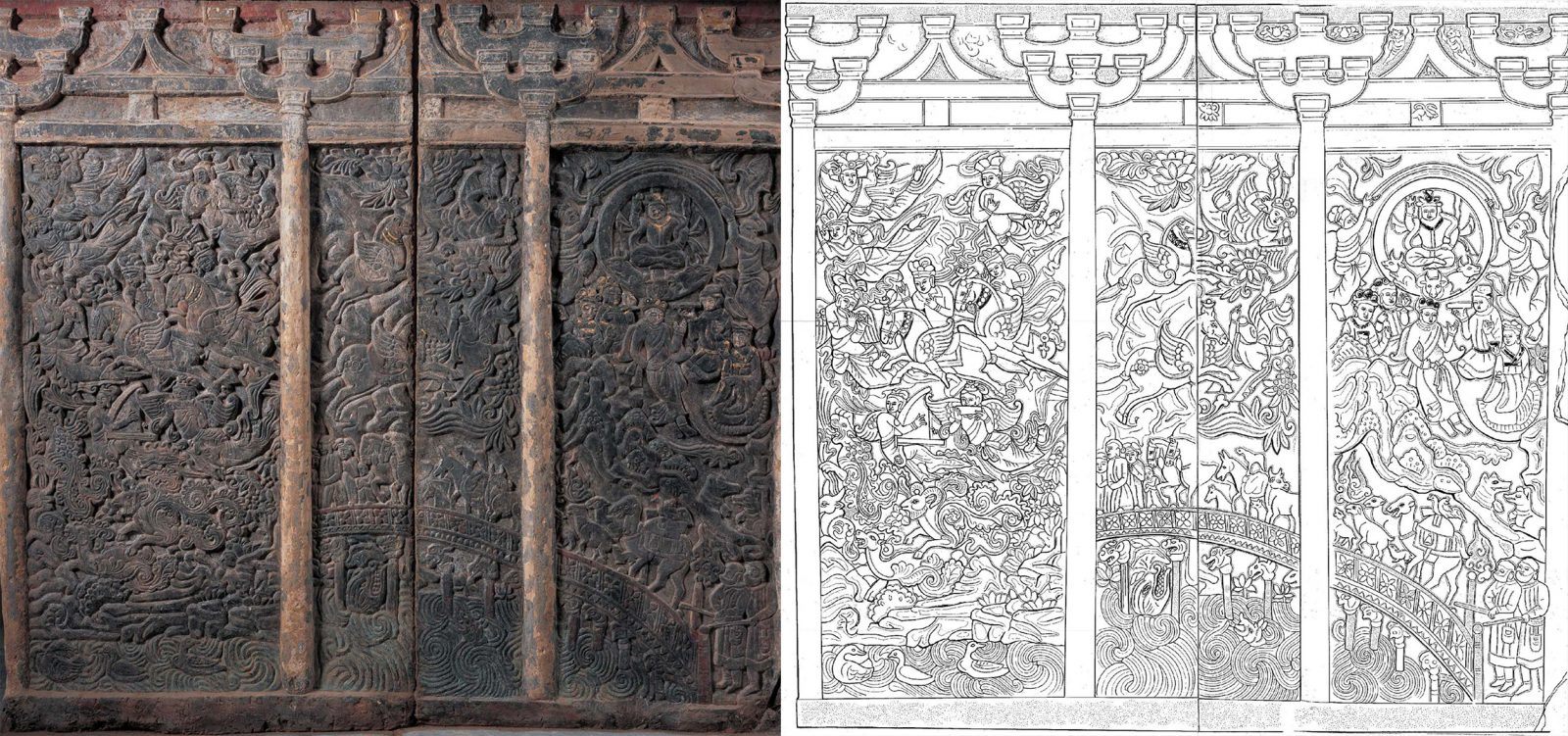Sharvara (Sanskrit: शार्वर), and Shyama (Sanskrit: शबल) are described to be two ferocious, four-eyed dogs that guard the entrance to the palace of Yama in the Vedic religion. The dead are required to get past these dogs in order to be rendered judgement by their master, Yama - the first man.
The dogs are first described in the Yamasukta section of the Rigveda. Named as the children of Sharama, departed souls are asked to venture beyond the two spotted four-eyed dogs in order to join their pitrs. They are also mentioned in a prayer to Yama, in which the dead are requested to be entrusted to their protection, and are extolled as the guardians of the road. The Atharvaveda describes the dogs as the messengers of Yama, designated with the role of seeking out individuals who are to die.
The word "Yama" means 'twin' (Yama has a twin sister, Yami), and later came to mean 'binder' (derived from "yam"); the word also means 'moral rule or duty' (i.e. dharma), 'self-control', 'forbearance', and 'cessation'.[18][19][20]
In the dialogue hymn between Yama and Yamī (Rig Veda 10.10), as the first two humans, Yamī tries to convince her twin brother Yama to have sex with her. Yamī makes a variety of arguments, including continuing the mortal line, that Tvashtar created them as a couple in the womb, and that Dyaush and Prithvi are famous for their incest. Yama argues that their ancestors, "the Gandharva in the waters and the watery maiden," as a reason not to commit incest, that Mitra-Varuna are strict in their ordinances, and that they have spies everywhere. By the end of the hymn, Yamī becomes frustrated but Yama remains firm in his stance. However, by RV 10.13.4, Yama is stated to have chosen to leave offspring, but Yamī is not mentioned.[13]
Yama is also known by many other names, including Kala ('time'), Pashi (one who carries a noose') and Dharmaraja ('lord of Dharma').[14]
In Vedic tradition, Yama was considered to be the first mortal who died and discovered the way to the celestial abodes;[15] thus, as a result, he became the ruler of the departed.[16] His role, characteristics, and abode have been expanded in texts such as the Upanishads, the Ramayana, the Mahabharata and the Puranas. Yama is described as the twin of Yami, and the son of the sun god Surya (in earlier traditions Vivasvat) and Sanjna. He judges the souls of the dead and depending on their deeds, he assigns them to the realm of the Pitris (forefathers), Naraka (hell), or be reborn on the earth.

The Chinvat Bridge or Cinvatô Peretûm, "bridge of judgement" or "beam-shaped bridge")[1] or the Bridge of the Requiter[2] in Zoroastrianism is the sifting bridge,[3] which separates the world of the living from the world of the dead. All souls must cross the bridge upon death. The bridge is guarded by two four-eyed dogs, described in the Videvdat (Vendidad) 13,9 as 'spâna pəšu.pâna' ("two bridge-guarding dogs").[4][5]
The Bridge's appearance varies depending on the observer's asha, or righteousness. As related in the text known as the Bundahishn, if a person has been wicked, the bridge will appear narrow and the demon Chinnaphapast will emerge[6] and drag their soul into the druj-demana (the House of Lies), a place of eternal punishment and suffering similar to the concept of Hell.[7] If a person's good thoughts, words and deeds in life are many, the bridge will be wide enough to cross, and the Daena, a spirit representing revelation, will appear and lead the soul into Garo Demana (the House of Song). Those souls that successfully cross the bridge are united with Ahura Mazda.
27. O Maker of the material world, thou Holy One! Where are the rewards given? Where does the rewarding take place? Where is the rewarding fulfilled? Whereto do men come to take the reward that, during their life in the material world, they have won for their souls?
28. Ahura Mazda answered: 'When the man is dead, when his time is over, then the wicked, evil-doing Daevas cut off his eyesight. On the third night, when the dawn appears and brightens up, when Mithra, the god with beautiful weapons, reaches the all-happy mountains, and the sun is rising
29. 'Then the fiend, named Vizaresha, O Spitama Zarathushtra, carries off in bonds the souls of the wicked Daeva-worshippers who live in sin. The soul enters the way made by Time, and open both to the wicked and to the righteous. At the head of the Chinwad bridge, the holy bridge made by Mazda, they ask for their spirits and souls the reward for the worldly goods which they gave away here below.
30. 'Then comes the beautiful, well-shapen, strong and well-formed maid, with the dogs at her sides, one who can distinguish, who has many children, happy, and of high understanding. 'She makes the soul of the righteous one go up above the Hara-berezaiti; above the Chinwad bridge she places it in the presence of the heavenly gods themselves.[14]